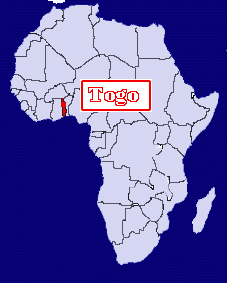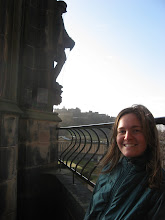Things are still going well in Togo. I had a great informational meeting the other day about our well and school garden project. Over 130 people came, and we didn't offer food or beer or anything! I think it was because myself and my counterpart hand delivered all the invitations to the chiefs of villages and village leaders. Also, we were vague in the invitation to make people extra curious. We had a good response from this and so will do it again.
 I've attached some pictures of my farm. I was given a small piece of land to experiment with different crops and techniques. I planted about ten rows of corn and peanuts and corn or corn and mucuna, a nitrogen fixing cover crop. Also I planted sweet potatoes (not quite like ours, more just like a potato that is sweet) and also made a permagarden, a permanent garden. This idea of a permagarden is that it is small, close to the house, and is primarily for the families consumption and thus a variety of things are planted. For the permagarden, it's the double digging (process of removing top soil and digging subsoil too to really loosen up the soil, making it easier for roots to penetrate the soil) and the addition of compost and ash that make the garden a success. I am really happy with how mine is looking, and you can see a difference between the corn I planted in the permagarden and the other corn I just planted. The hard part about convincing people to try to permagarden is that people (those who can afford it) rely on chemical fertilizers. Every time people see me in my garden they ask me, 'did you add fertiizer yet?' I would say yes, I added traditional/organic fertilizer, (compost) but when people eyed my yellow corn with small ears, I didn't feel I was doing any convincing. Chemical fertilizers work fast, and making compost is another task to do in the already busy rainy season. I'm going to try convincing people to make compost during dry season when there is more time. If I can get some people to try it, that would be great. We'll also be focusing on the permagarden for our school garden.
I've attached some pictures of my farm. I was given a small piece of land to experiment with different crops and techniques. I planted about ten rows of corn and peanuts and corn or corn and mucuna, a nitrogen fixing cover crop. Also I planted sweet potatoes (not quite like ours, more just like a potato that is sweet) and also made a permagarden, a permanent garden. This idea of a permagarden is that it is small, close to the house, and is primarily for the families consumption and thus a variety of things are planted. For the permagarden, it's the double digging (process of removing top soil and digging subsoil too to really loosen up the soil, making it easier for roots to penetrate the soil) and the addition of compost and ash that make the garden a success. I am really happy with how mine is looking, and you can see a difference between the corn I planted in the permagarden and the other corn I just planted. The hard part about convincing people to try to permagarden is that people (those who can afford it) rely on chemical fertilizers. Every time people see me in my garden they ask me, 'did you add fertiizer yet?' I would say yes, I added traditional/organic fertilizer, (compost) but when people eyed my yellow corn with small ears, I didn't feel I was doing any convincing. Chemical fertilizers work fast, and making compost is another task to do in the already busy rainy season. I'm going to try convincing people to make compost during dry season when there is more time. If I can get some people to try it, that would be great. We'll also be focusing on the permagarden for our school garden. I am currently in Lome where myself and three other volunteers just finished up a Farm to Market publication. Farm to Market is a PC Togo journal published quarterly. It is our job to search for articles written by other volunteers and staff, edit them, edit the French articles, and then format the articles in InDesign, a page making program. It is fun, but formatting and margin fixing can be tedious! I am learning a lot though.
I've included an article I wrote for the June issue below.Finally, a new training group of volunteers is arriving today. It is exciting, and reminds me that one year ago, it was me getting off that plane. All I can say is that time has flown, and I really enjoy life and work here.
Happy fall!
My farm to market article:
Participatory Approach for Community Action (PACA) is an awesome and easy activity to do in your community, whether you’re looking for project ideas or just wanting to know your community better. Getting people to talk about their own community will lead to great discussions where people are engaged and eager to participate. Plus, who better knows the community than the people in it? Recently in village, I did two PACA sessions with a women’s group and here’s how they went.
For the first session, we chose to make a community map. Some questions we posed to help in map making included, where do you go every day, what do you do there, and why? The women divided themselves into groups and drew two maps which were then discussed and differences gathered. Just by looking at the maps, the women concluded that there were not enough wells, which with dry season led to water scarcity. Ok, being in the north, this is a common problem, but what else could these maps tell us?
During the second PACA session two weeks later, we pulled out the maps and did a needs assessment. First, I asked for them to list all the positive things they saw on the maps. We quickly filled our flip chart with things like schools, the village dispensary, the market, trees, and farm land. Next, we made a list of things we didn’t have and things we are lacking in village. While lack of electricity and running water aren’t quick fixes, other items on the list were things that we, within our community and without outside help, could find a solution.
I’ll give two examples of problems we were able to solve. The second negative item on the list was disease, specifically diarreal related. Washing hands with soap can reduce diarrheal disease by 45% (data thanks to the April issue of National Geographic, all of which is about water and really captivating). So what’s the solution? We decided to make liquid soap in an upcoming meeting and to talk about why it is important to and how one should wash their hands. Farther down the list of negatives was a lack of edible leaves for making sauce like adema. I asked them why, and the women explained that insects came and routinely damaged their crops. Solution: Mixing up some natural pesticide solution using piment, garlic, neem leaves and soap, all things readily available in our village. It was very exciting doing this exercise, working together to find the principle concerns of the community and, even better, knowing that you, the volunteer, have the information (in this case liquid soap and natural pesticide recipes) to help solve their problems.
A final happy moment, while making the list of things our community is lacking, was when the women cited something negative that actually turned out to be something positive. The community needed money to buy cement to make compound floors with. I asked them what they do instead and they explained the process of pounding clay mixed with a little water so that it forms a decently, hard floor. (We had recently done this in my compound for my host sister). Even better, this activity is done by a party of women, who come together and help one another to complete the project. It’s no cement, but finding an alternative to something you don’t have or can’t afford using locally available resources is what PACA is all about. In this case, the resource was clay, but more importantly, the greatest resource is the people themselves.





No comments:
Post a Comment